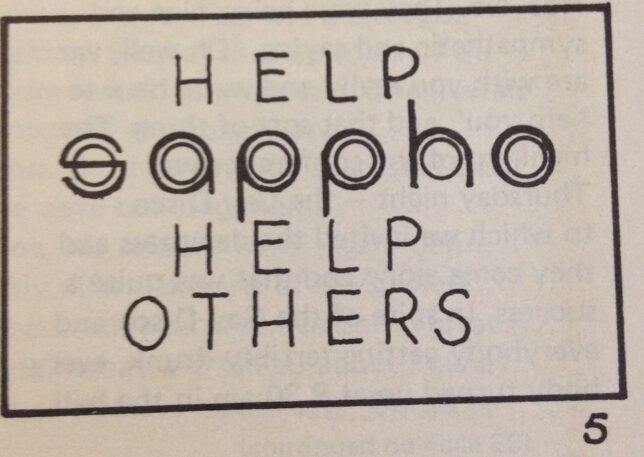
This is the first in a series of four blog posts discussing and reframing Sappho magazine, a gay women’s publication that ran from 1972 until 1981. For my research I have been reading the extensive collection from the Lesbian Archives in Glasgow Women’s Library and I have come to consider Sappho a transformative, relevant publication that pushed vigorously for the rights of LGBTQ women and provided a voice and comfort for many lonely women struggling with the difficulties thrown at them by homophobic society. This was a period of time that interestingly reflects lesbian, trans and queer women’s increasing visibility and Sappho consistently engages with both the personal and political struggles for women attempting to live a fulfilled existence despite the breadth of problems and adversities they had to face. It has been an eye opening and enriching experience to re-visit these women’s voices and engage with them from a modern perspective. Many of them are still insightful, emotional and very valid to engage with how modern society has progressed but also some of the lingering problems that we still face.
My interest in this stemmed from my love of the Adrienne Rich’s formative essay Compulsory Heterosexuality and Lesbian Existence published towards the end of Sappho’s run in 1980 (this text can be accessed in GWL). This text investigates the concept of compulsory heterosexuality and how this has instilled oppression over women, their sexuality and their economic development and freedom:
“The institutions by which women have traditionally been controlled – patriarchal motherhood, economic exploitation, the nuclear family, compulsory heterosexuality – are being strengthened by legislation, religious fiat, media imagery, and the efforts of censorship.” (1980:1763)
For me, Rich solidifies the many detrimental difficulties facing women and it was fascinating reading Sappho and becoming enlightened to it’s consistent presentation of these topics from the voices of a vast span of women from different ethnicities, social classes and personal situations. It became apparent that this was the beginning of a complicated, impassioned and controversial and often harrowing dialogue for women. I felt they were representing the beginning of gay women’s visibility by opening up and engaging feelings that had been suffocated by society and this in turn presents the welcome emotional relief of many lonely lesbian women. Sappho gave women an important platform and as they specifically state their intentions in one of the first publications in 1972:
“Sappho is not intended to be read furtively and hidden under the layers of guilty mattresses. Those with courage will speak out through Sappho and by all other possible means to improve the quality of the homophile condition provided shy sisters are timely supportive by doing their own thing in a positive way.” (Volume 1, No. 7)
This developed Sappho’s fighting spirit and determination to be a publication that still reads as liberating because of the commitment to speaking out. Throughout the first volume of editions many women open up and tell their (often heartbreakingly) personal stories in the section Happy Families. One example sums up the need for women to be more open about their sexuality so they can reduce the stigma that came with identifying and living as a lesbian. In No.5 Bella Ashbey heartbreaking states:
“As a non-practising lesbian my great fear is that I would die if I had passed on what I personally consider to be an infliction, to my children. I must underline the phrase “non-practising” because I feel that is for those of us who come under this heading that life is a living hell.”
Stories like hers make us realise how difficult it was during the early seventies to live and develop relationships that were considered unacceptable and abnormal. There are many stories of women that chose heterosexual marriages because they thought there was something wrong with their attraction to other women. Society instilled this and Sappho decided to fight back. Sappho’s importance is that they were always presenting the turmoil and impact of such sad circumstances and this incited an emotional reaction that promotes change and highlights the unacceptability of gendered oppression.

One reply on “Sappho and Lesbian Visibility – Making the Personal Political”
[…] https://womenslibrary.org.uk/2016/09/14/sappho-and-lesbian-visibility-making-the-personal-political/ […]